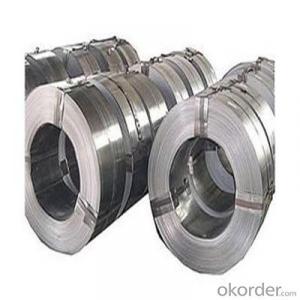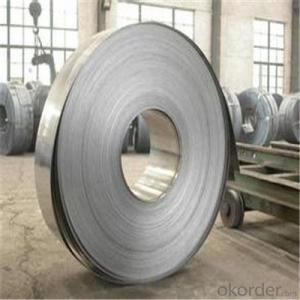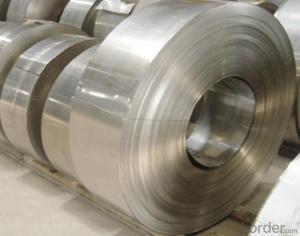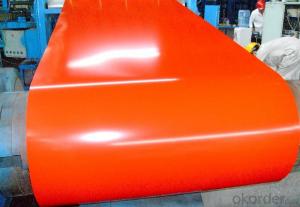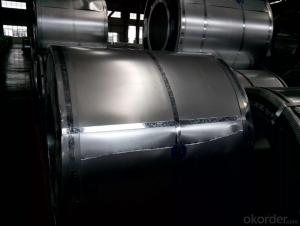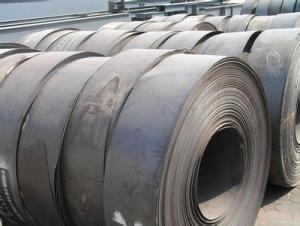Hot Rolled Steel Strip Coils with high quality in China
- Loading Port:
- Tianjin
- Payment Terms:
- TT OR LC
- Min Order Qty:
- 55 m.t.
- Supply Capability:
- 222555 m.t./month
OKorder Service Pledge
OKorder Financial Service
You Might Also Like
Item specifice
Applications of Steel Strip Coils:
1:Chemical industry equipment, Industrial tanks
2:Medical Instruments,Tableware, Kitchen utensil,kitchen ware
3:Architectural purpose, Milk & Food processing facilities
4:Hospital Equipment, interior Exterior decoration for building
5:Architectural purposes, escalators, kitchen ware,vehicles
Festures of Steel Strip Coils:
1. Each coil is closely covered by oil paper or plastic film.
2. Outside it is firmly packed with sack cloth or compound paper.
3. Steel strap or PP strap to pack the outside to ensure safety.
4. On/about 1000kgs to be packed with one wooden pallet.
5. Strips can be loaded to 20'FCL without pallet if required by customer.
6. LCL shipment can also be arranged once required by the customer.
Specifications of Steel Strip Coils:
Household Appliance | Refrigerator shutter &side panels, Rice Cooker, Washer, Microwave Ovens, Freezers, Air conditions, Water Heaters, Sterilization Cabinets, Range Hoods, Computer Panels , DVD/DVB panels, TV back panel etc. |
Construction Material | Fireproof Door &Kitchen Cabinet ,Ceiling, Sanitary Unit, Elevator etc. |
Transportation | Car, Ship, Trains, Aircraft Equipment. etc. |
Education and Health Field | Electronic Writing Boards, Projection Screens, Clean Operating Rooms, etc. |
Images of Steel Strip Coils:
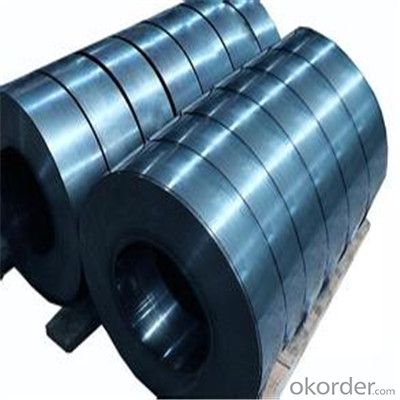
FAQ
1.What's your MOQ?
25MT, it is for one container.
2.Do you have QC teams?
Yeah, sure, our QC team is very important, they will keep the quality control for our products.
3. What's your normal delivery time?
Our delivery time about 10-20days for standard sizes, if you have other requirements like hardness and width ,it is about 20-40days.
- Q:How are steel strips transported from the manufacturing facility to the end-user?
- Steel strips are transported from the manufacturing facility to the end-user through various modes of transportation. The most common methods include trucking, rail transportation, and shipping. Trucking is often employed for shorter distances or when the end-user is located in a nearby area. Steel strips are loaded onto flatbed trucks, which provide a convenient and efficient means of transportation. This method allows for flexibility in terms of timing and delivery locations, as trucks can access even remote areas. Rail transportation is preferred for longer distances or when the end-user is situated in a different region or country. Steel strips are loaded onto railcars, which are specifically designed to carry heavy loads. Rail transport offers cost-effective solutions due to its ability to carry large quantities of steel strips at once. Additionally, it is a more environmentally friendly option compared to trucking. Shipping is utilized when the end-user is located in a different country or continent. Steel strips are loaded into containers and transported via cargo ships. This method is suitable for long-distance transportation and allows for efficient movement of large volumes of steel strips at a time. However, shipping may take longer compared to other modes of transportation due to the time required for customs clearance and port handling. Regardless of the mode of transportation chosen, it is crucial to ensure the proper packaging and securing of steel strips to prevent damage during transit. Additionally, logistics companies and freight forwarders play a vital role in coordinating the transportation process, including arranging the necessary documentation, customs clearance, and tracking the shipment to ensure timely delivery to the end-user.
- Q:Are steel strips suitable for making plumbing fixtures?
- Yes, steel strips can be suitable for making plumbing fixtures. Steel is a durable and strong material that can withstand high pressure and temperature, making it ideal for plumbing applications. Steel strips can be easily formed and shaped into various plumbing fixtures such as pipes, fittings, and valves. Additionally, steel has corrosion-resistant properties, which is crucial for plumbing fixtures that come in contact with water and other corrosive substances. Steel strips are also readily available in different sizes and thicknesses, offering flexibility in designing and manufacturing plumbing fixtures. However, it is important to consider the specific requirements of the plumbing system and consult with experts to ensure that the chosen steel strips meet the necessary standards and regulations for plumbing fixtures.
- Q:How are steel strips formed into different shapes?
- Steel strips are formed into different shapes through a process called steel strip forming. This process involves several steps to manipulate the steel strips into desired shapes. Firstly, the steel strips are uncoiled from a large steel coil and fed into a forming machine. This machine uses a series of rollers, dies, and press brakes to shape the steel strips. The rollers apply pressure to the strips, gradually bending and curving them into the desired shape. The dies and press brakes are used to further shape the steel strips by applying precise amounts of force at specific points. This allows for the creation of more complex shapes and angles. In some cases, heat may be applied to the steel strips during the forming process to make them more malleable and easier to shape. This is particularly common when forming steel strips into intricate or tight shapes. Once the desired shape has been achieved, the steel strips are cooled and cut to the required length. They are then ready for further processing or use in various industries, such as automotive, construction, or manufacturing. Overall, the process of forming steel strips into different shapes involves a combination of mechanical force, heat, and precision engineering techniques to create the desired end product.
- Q:Can steel strips be used for making architectural panels?
- Yes, steel strips can be used for making architectural panels. Steel strips offer durability, strength, and flexibility, making them suitable for various architectural applications, including paneling.
- Q:Can steel strips be used in the manufacturing of electrical components?
- Yes, steel strips can be used in the manufacturing of electrical components. Steel strips are commonly used as a base material in the production of electrical components such as transformer cores, motor laminations, and electrical connectors. The steel strips provide the necessary strength, durability, and magnetic properties required for these applications.
- Q:How are steel strips processed for surface bending?
- Various methods are employed to process steel strips for surface bending. The initial step in the process involves selecting the appropriate steel grade and thickness for the desired application. Once the steel strips have been chosen, they undergo cleaning and preparation before bending. Roll forming machines are commonly utilized to bend the surface of steel strips. These machines consist of a series of rollers that gradually shape the strip into the desired form. The strip is fed through the machine, and each roller applies a small amount of force, gradually bending the strip. This process enables precise and consistent bending. Another approach to surface bending is press braking. This technique involves the use of a hydraulic or mechanical press to bend the strip. The strip is positioned between a punch and a die, and pressure is applied, causing the strip to bend. Press braking is suitable for both small and large bends, and it allows for the formation of more intricate shapes. In some instances, heat is applied to aid in the bending process, known as hot bending. This method is typically used for thicker steel strips. The strip is heated to a specific temperature and then shaped into the desired form. The heat softens the steel, making it more malleable and easier to bend. Following the surface bending process, the steel strips may undergo additional treatments such as annealing or tempering to enhance their strength and durability. These treatments help to eliminate internal stresses caused by bending and improve the overall performance of the steel. In conclusion, steel strips can be processed for surface bending using various methods, including roll forming, press braking, and hot bending. The selection of the technique depends on factors such as the desired shape, strip thickness, and specific application requirements.
- Q:Can steel strips be used for making electrical connectors in electronic devices?
- Yes, steel strips can be used for making electrical connectors in electronic devices. Steel strips are commonly used in the manufacturing of electrical connectors due to their high conductivity and durability. They provide a reliable and efficient connection between different components in electronic devices. Steel strips can be easily shaped and formed into various connector designs, allowing for versatility in their usage. Additionally, steel strips offer excellent resistance to corrosion, ensuring the longevity of the connectors. Overall, steel strips are a suitable material choice for making electrical connectors in electronic devices.
- Q:What is the typical thickness range of steel strips?
- The typical thickness range of steel strips varies depending on the specific application, but it generally falls within the range of 0.1 millimeters to 6 millimeters.
- Q:Are steel strips suitable for making conveyor belts or chains?
- Yes, steel strips are suitable for making conveyor belts or chains due to their high strength, durability, and resistance to wear and tear. They can withstand heavy loads and provide a stable and reliable material for efficient transportation systems.
- Q:Can steel strips be heat treated to improve their properties?
- The properties of steel strips can be enhanced through heat treatment. Heat treatment involves controlled heating and cooling of steel to modify its physical and mechanical properties. This method can improve the hardness, strength, toughness, and resistance to wear or corrosion of the steel. Steel strips can undergo different heat treatment methods, such as annealing, quenching, tempering, and case hardening. Annealing relieves internal stresses and improves ductility by heating the steel to a specific temperature and slowly cooling it. Quenching rapidly cools the steel after heating, increasing its hardness and strength. Tempering, which follows quenching, involves reheating the steel to a specific temperature and then cooling it again to decrease brittleness and increase toughness. Case hardening is another heat treatment technique for steel strips. It hardens the surface layer to enhance wear resistance while maintaining a relatively softer core for toughness. This is accomplished by introducing carbon or nitrogen into the surface layer and then subjecting the steel to heating and cooling. Heat treatment plays a vital role in the production of steel strips as it allows manufacturers to customize the material's properties for specific applications. By carefully controlling the heating and cooling processes, steel strips can be optimized for desired characteristics such as strength, hardness, ductility, and more.
1. Manufacturer Overview |
|
|---|---|
| Location | |
| Year Established | |
| Annual Output Value | |
| Main Markets | |
| Company Certifications | |
2. Manufacturer Certificates |
|
|---|---|
| a) Certification Name | |
| Range | |
| Reference | |
| Validity Period | |
3. Manufacturer Capability |
|
|---|---|
| a)Trade Capacity | |
| Nearest Port | |
| Export Percentage | |
| No.of Employees in Trade Department | |
| Language Spoken: | |
| b)Factory Information | |
| Factory Size: | |
| No. of Production Lines | |
| Contract Manufacturing | |
| Product Price Range | |
Send your message to us
Hot Rolled Steel Strip Coils with high quality in China
- Loading Port:
- Tianjin
- Payment Terms:
- TT OR LC
- Min Order Qty:
- 55 m.t.
- Supply Capability:
- 222555 m.t./month
OKorder Service Pledge
OKorder Financial Service
Similar products
New products
Hot products
Related keywords
